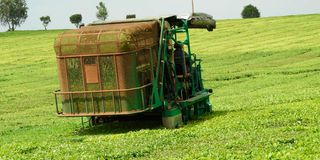What State must do so as to improve tea subsector

A tea plucking machine in operation at a tea estate in Kericho county.
Deputy President Rigathi Gachagua, who is leading the government’s bid to reform the tea subsector, has this week been meeting tea stakeholders, including farmers, in Kericho.
Understandably, tea subsector reforms are part of the strategy of fulfilling the Kenya Kwanza administration promise of uplifting the people at the bottom of the economic pyramid, including the farmer in the tea, dairy and coffee subsectors.
But while the aim is putting back money into the pocket of the farmer, the reforms are also a long-term strategy of addressing the soaring cost of living amid national and international factors like drought and wars.
For instance, with the drought reducing agricultural produce, importation of maize and other foods became the temporal remedy for food security. But that depletes foreign currency, yet tea harvest had gone down due to low rainfall.
In 2022, Kenya produced 535,000 tonnes of tea, down from 537,800 tonnes the previous year, but earnings increased to Sh163.3 billion from Sh130.9 billion. Tea, therefore, accounted for 20.9 per cent of earnings from domestic exports. Besides the demand for US dollars, additional requirement of the greenback for food importation of food, oil and other goods threatened the reserves, escalating the cost of living with the shilling under pressure.
The tea market might exceed $100 billion by 2031. With increased exports to traditional markets like Pakistan, whose consumption rose by 20.6 per cent in 2022, the growing international market and the projected consumption spell good times ahead for the more than 650,000 farmers and over six million others who derive a livelihood from the subsector.
President William Ruto has described the country exporting up to 95 per cent tea without value addition as a raw deal for small-holder farmers, who are struggling economically. This is also reflected at the national level, as the country strives to stabilise foreign exchange. Tea contributes at least two per cent to the gross domestic product (GDP).
High cost
Myriad challenges in the tea subsector include high cost of electricity and farm inputs, labour, poor infrastructure, low adoption of modern technology, competition from other beverages and the escalating adverse effects of climate change.
According to KTDA, the costs of electricity, firewood and labour account for half of the cost of production. Based on majority payment of Sh21, labour costs account over half of income for the tea produced. Besides, most roads in tea-growing regions require a facelift.
The envisaged reforms resonate with the Bottom-Up Economic Transformation Agenda, which is aimed at delivering a stronger economy. But in its approach of executing legal, policy and administrative reforms, the government has to address the challenges that one of the strongest economic subsectors, whose market benefits have not improved the life of the farmer due to cartels, faces.
Besides sourcing for new markets and maintaining the existing ones—such as Egypt, Pakistan, the United Kingdom and the United Arab Emirates (UAE)—value addition for product diversification will create new frontiers in meeting specialised demand.
Further, under the African Continental, Free Trade Area (AfCFTA), the government needs to promote tea in the little-tapped African market of more than 1.3 billion people. This will cushion the farmer against global market instabilities.
Short-, medium- and long-term reforms in the tea subsector will not only increase the purchasing power of the farmer through increased earnings but also help to shield the shilling against fluctuation in value and help to lower the cost of living.
- Ms Ngure is a strategic communications consultant. [email protected].





